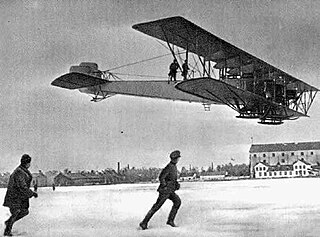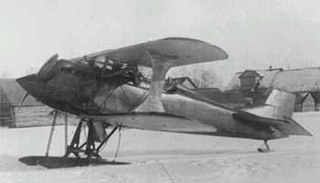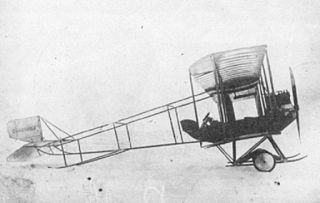
The Sikorsky Ilya Muromets were a class of Russian pre-World War I large four-engine commercial airliners and military heavy bombers used during World War I by the Russian Empire. The aircraft series was named after Ilya Muromets, a hero from Slavic mythology. The series was based on the Russky Vityaz or Le Grand, the world's first four-engined aircraft, designed by Igor Sikorsky. The Ilya Muromets aircraft as it appeared in 1913 was a revolutionary design, intended for commercial service with its spacious fuselage incorporating a passenger saloon and washroom on board. The Ilya Muromets was the world's first multi-engine aircraft in production and at least sixty were built. During World War I, it became the first four-engine bomber to equip a dedicated strategic bombing unit. This heavy bomber was unrivaled in the early stages of the war, as the Central Powers had no aircraft capable enough to rival it until much later.

The Grigorovich I-2 was a biplane fighter aircraft of the Soviet Union, the first indigenous fighter to enter service in substantial numbers. Developed from the Grigorovich I-1, it first flew on 4 November 1924, piloted by A.I. Zhukov. The M-5 engine was a Soviet copy of the Liberty L-12.

Grigorovich M-5 was a successful Russian World War I-era two-bay unequal-span biplane flying boat with a single step hull, designed by Grigorovich. It was the first mass production flying boat built in Russia.

The Avro 510 was a two-seat racing seaplane designed by Avro to compete in the 1914 Circuit of Britain Race. It was a conventional two-bay biplane of greatly uneven span, equipped with two large central floats and two outriggers. The race was called off at the outbreak of the First World War, but the British Admiralty was aware of the type and ordered five examples, with modified floats and tail. In service, these proved completely unsuitable, and it was discovered that with a second person aboard, the aircraft could barely fly. In October 1915, the 510s in service were sent to Supermarine for modification and improvement, but by March the following year all were removed from service.

The International F-17 Sportsman was a 1920s American three-seat open-cockpit biplane designed and manufactured by the International Aircraft Corporation in Long Beach, California and Cincinnati, Ohio. 107 aircraft were built, 77 of them at Cincinnati.

The Focke-Wulf A 20 Habicht was an airliner developed in Germany in the late 1920s. It was a high-wing cantilever monoplane with fixed tailskid undercarriage. The fuselage was deep and seated four passengers in a fully enclosed cabin. The type was not bought by the airlines and only a few examples were built.

The Sikorsky S-16, or RBVZ S-XVI, was a Russian equi-span single-bay two-seat biplane designed by Igor Sikorsky in 1914-15. Conceived in response to demand for an escort fighter for the Ilya Muromets bombers, it was noteworthy in that it was one of the first aircraft to possess synchronisation gear for its 7.7 mm machine gun. The first S-XVI was completed on 6 February 1915 with an 80 hp engine instead of the intended 100 hp because of supply problems. On 17 December 1915, the Russian government placed an order for 18 aircraft, these being delivered in early 1916.

The Sikorsky S-20 or RBVZ S-XX was a Russian single-bay unequal span two-seat biplane designed by Igor Sikorsky in 1916. Displaying some Nieuport influence, it saw very little service during World War I.

The Sikorsky S-10 was a Russian military twin-float seaplane that served with the Russian Navy's Baltic Fleet from the summer of 1913 to 1915. After Igor Sikorsky built the successful Sikorsky S-6 for the Russian military, he tried to build another successful aircraft for them. The S-10 was a modified S-6B built by the Russo-Baltic Carriage Factory. Approximately sixteen production versions of the S-10 were built. It had a less powerful engine and generally weaker structure than the S-6. They had either an 80 hp Gnome Monosoupape or a 100 hp Argus Motoren engine. Some were deployed on the world's first operational seaplane carriers.
The Sopwith B.1 was an experimental British bomber aircraft of the First World War. A single-seat, single-engined biplane, the B.1 was built by the Sopwith Aviation Company for the Royal Navy. Although only two were built, one was used for bombing raids over France.

The Anatra Anadis was developed in 1916 as a single-seat fighter variant of the Anatra Anasal reconnaissance biplane. The main difference between the two aircraft was the streamlined fuselage, the lack of a rear seat in the Anadis, plans for a forward-firing gun and a different engine.

The Sikorsky S-7 was a Russian single engine experimental prototype aircraft built by the Russian Baltic Railroad Car Works shortly after Igor Sikorsky became chief engineer of the aircraft manufacturing division.

The Sikorsky S-2 was the second fixed-wing aircraft designed by Igor Sikorsky using the main wing section from the S-1 and a 19 kW (25 hp) Anzani 3 three-cylinder engine in a tractor configuration. During the first flight attempt on June 3, 1910, the biplane reached a height of two to four feet and traveled approximately 200 m (200 yd). After several successful flights the S-2 was destroyed on June 30 when Sikorsky inadvertently stalled the underpowered aircraft at an altitude of 20 m (70 ft).

The Sikorsky S-1 was the first fixed-wing aircraft design by Igor Sikorsky. In February 1910 work began on the pusher configured biplane powered by a 15 hp (11 kW) Anzani three-cylinder, air-cooled engine. The machine was completed in April and Sikorsky began his first attempts at flight. In early May during a take-off attempt on a windy day the machine briefly became airborne due mostly to a favorable headwind. Further attempts were less successful, and Sikorsky disassembled it, saving the main wing section to construct the S-2.

The Sikorsky S-6 was a Russian single engine experimental aircraft similar to the S-5, built in 1911 by Igor Sikorsky.

The Sikorsky S-4 was a Russian aircraft built by Igor Sikorsky using many components of the S-3 including the 40 hp (30 kW) Anzani three-cylinder engine. Construction of the biplane began in late December 1910 and was completed early in the spring of 1911. The machine appeared in a static display at an aeronautical exhibition at Kharkov in the spring of 1911, but was never flown. Some time afterward it was disassembled.

The Sikorsky S-9Kruglyj was a Russian single engine prototype aircraft completed in the spring of 1913 by the Russian Baltic Railroad Car Works while Igor Sikorsky was the chief engineer of the aircraft manufacturing division.

The Sikorsky S-11 Polukroogly was a Russian single engine prototype reconnaissance aircraft completed in July 1913 by the Russian Baltic Railroad Car Works while Igor Sikorsky was the chief engineer of the aircraft manufacturing division.

The Sikorsky S-12 was a Russian single engine trainer aircraft completed in the spring of 1913 by the Russian Baltic Railroad Car Works while Igor Sikorsky was the chief engineer of the aircraft manufacturing division.

The Sikorsky S-18 was a Russian twin engine aircraft designed by Igor Sikorsky and built by the Russian Baltic Railroad Car Works aviation division at Petrograd during World War I.




















